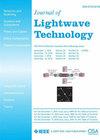S/C/L-Band Transmission in Few-Mode MCF With Optical Frequency Comb Regeneration via Single-Mode Core Seed Distribution
IF 4.1
1区 工程技术
Q2 ENGINEERING, ELECTRICAL & ELECTRONIC
引用次数: 0
Abstract
We demonstrate parametric optical frequency comb (OFC) regeneration based on a transmitted seed in a high spatial density SDM fiber with 114 spatial channels and a seed distribution core. We show that such a fiber is compatible with ultra-high data rate links in a recently proposed network architecture that exploits the synergy between SDM fibers and OFC technology, extending this network concept to include few-mode cores for the first time. The employed OFCs support the generation of 650 x 25 GHz-spaced carriers covering the S/C/L-band for a total useful bandwidth of 134 nm, i.e., 50% wider than previously demonstrated with an OFC. Data rates of approximately 330 Tb/s per few-mode core are measured, with a potential of more than 12.7 Pb/s per fiber. We show that the use of OFCs for both transmission and detection simplifies coherent reception with a 3 orders of magnitude lower frequency offset compared to conventional intradyne schemes. We also show that the phase coherence among the comb carriers can be exploited to share digital signal processing (DSP) resources among the received channels. These results demonstrate the potential of OFCs for high-capacity networking, capable of replacing hundreds of transceiver lasers in each node and simplifying the DSP through the use of coherent and frequency-locked carriers.求助全文
约1分钟内获得全文
求助全文
来源期刊

Journal of Lightwave Technology
工程技术-工程:电子与电气
CiteScore
9.40
自引率
14.90%
发文量
936
审稿时长
3.9 months
期刊介绍:
The Journal of Lightwave Technology is comprised of original contributions, both regular papers and letters, covering work in all aspects of optical guided-wave science, technology, and engineering. Manuscripts are solicited which report original theoretical and/or experimental results which advance the technological base of guided-wave technology. Tutorial and review papers are by invitation only. Topics of interest include the following: fiber and cable technologies, active and passive guided-wave componentry (light sources, detectors, repeaters, switches, fiber sensors, etc.); integrated optics and optoelectronics; and systems, subsystems, new applications and unique field trials. System oriented manuscripts should be concerned with systems which perform a function not previously available, out-perform previously established systems, or represent enhancements in the state of the art in general.
 求助内容:
求助内容: 应助结果提醒方式:
应助结果提醒方式:


